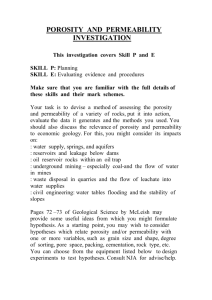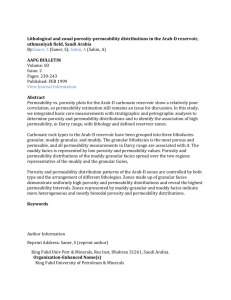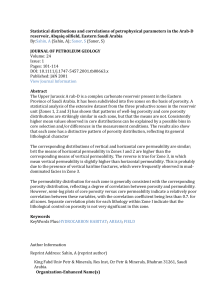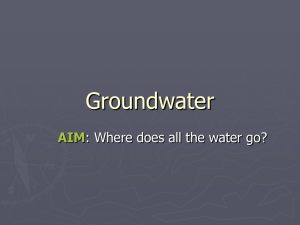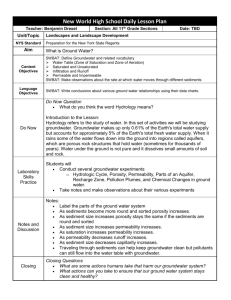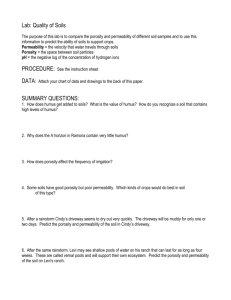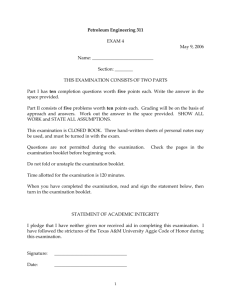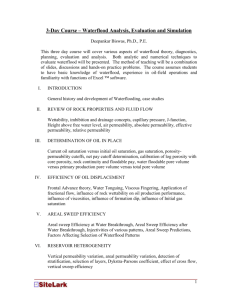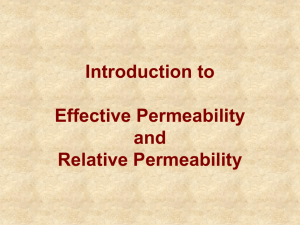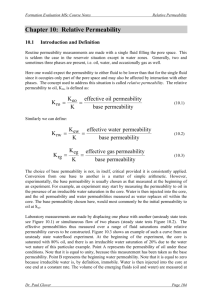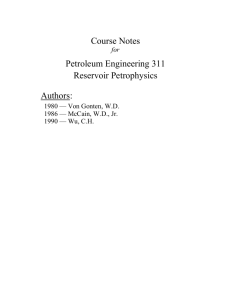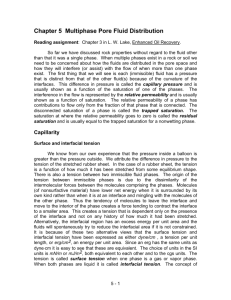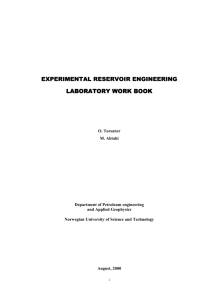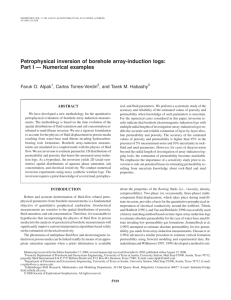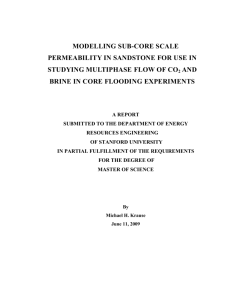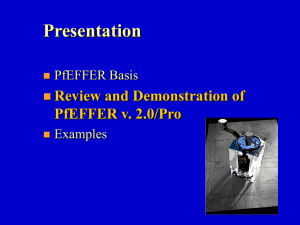Bulk Volume Water (BVW)
advertisement
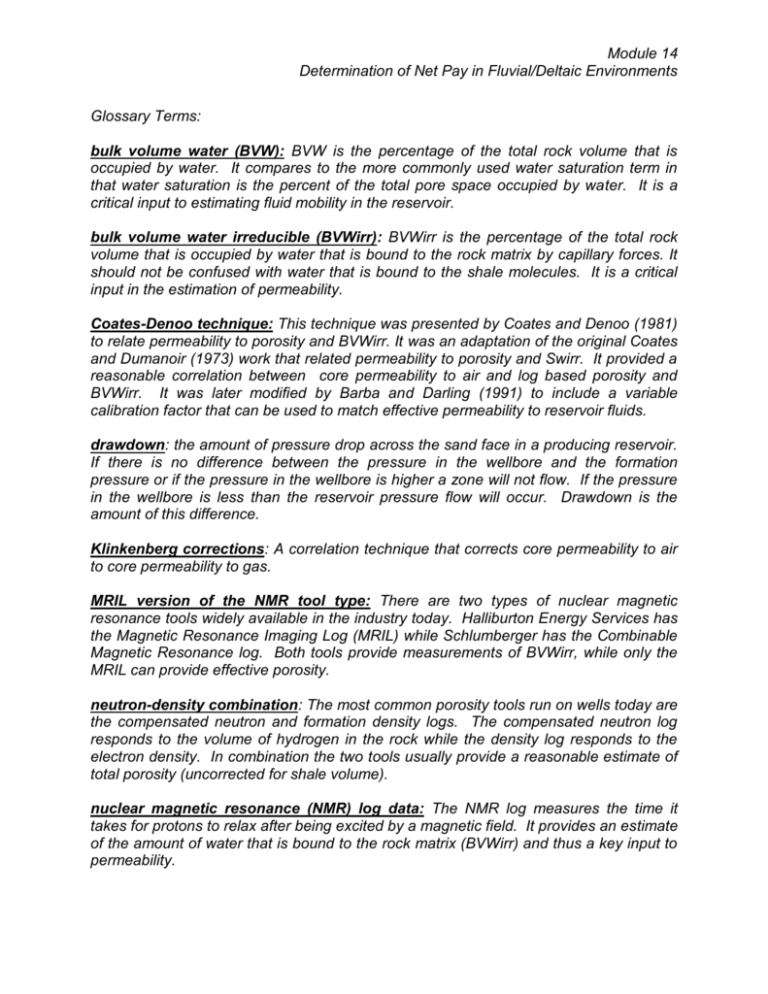
Module 14 Determination of Net Pay in Fluvial/Deltaic Environments Glossary Terms: bulk volume water (BVW): BVW is the percentage of the total rock volume that is occupied by water. It compares to the more commonly used water saturation term in that water saturation is the percent of the total pore space occupied by water. It is a critical input to estimating fluid mobility in the reservoir. bulk volume water irreducible (BVWirr): BVWirr is the percentage of the total rock volume that is occupied by water that is bound to the rock matrix by capillary forces. It should not be confused with water that is bound to the shale molecules. It is a critical input in the estimation of permeability. Coates-Denoo technique: This technique was presented by Coates and Denoo (1981) to relate permeability to porosity and BVWirr. It was an adaptation of the original Coates and Dumanoir (1973) work that related permeability to porosity and Swirr. It provided a reasonable correlation between core permeability to air and log based porosity and BVWirr. It was later modified by Barba and Darling (1991) to include a variable calibration factor that can be used to match effective permeability to reservoir fluids. drawdown: the amount of pressure drop across the sand face in a producing reservoir. If there is no difference between the pressure in the wellbore and the formation pressure or if the pressure in the wellbore is higher a zone will not flow. If the pressure in the wellbore is less than the reservoir pressure flow will occur. Drawdown is the amount of this difference. Klinkenberg corrections: A correlation technique that corrects core permeability to air to core permeability to gas. MRIL version of the NMR tool type: There are two types of nuclear magnetic resonance tools widely available in the industry today. Halliburton Energy Services has the Magnetic Resonance Imaging Log (MRIL) while Schlumberger has the Combinable Magnetic Resonance log. Both tools provide measurements of BVWirr, while only the MRIL can provide effective porosity. neutron-density combination: The most common porosity tools run on wells today are the compensated neutron and formation density logs. The compensated neutron log responds to the volume of hydrogen in the rock while the density log responds to the electron density. In combination the two tools usually provide a reasonable estimate of total porosity (uncorrected for shale volume). nuclear magnetic resonance (NMR) log data: The NMR log measures the time it takes for protons to relax after being excited by a magnetic field. It provides an estimate of the amount of water that is bound to the rock matrix (BVWirr) and thus a key input to permeability. Module 14 Determination of Net Pay in Fluvial/Deltaic Environments permeability: a measurement of fluid mobility, usually expressed in one thousandths of a Darcy or millidarcy. It is a key component of net pay as wells with low or no permeability will not produce economic quantities of hydrocarbons. Simandoux water saturation equation: Conventional wireline logs cannot measure the volume of hydrocarbons directly. They measure the volume of salt water in the rock, and from this infer an oil volume from the difference between the pore volume in the rock and the volume of water. When formations contain no clays the water saturation can be obtained directly from the porosity and resistivity logs. Virtually all sands in fluvial/deltaic environments contain clay, however, and an adjustment needs to be made to the conventional water saturation relationships to account for the effect of clay resistivity. The Simandoux model is one of the most widely used in this area. skin damage: During the drilling phase of well construction the primary objective is to plug off the well to keep it from blowing out. Large volumes of water and mud invade the formation in this process. When the casing is cemented large volumes of water are also lost. All of this material creates obstacles to the flow of reservoir fluids once the production phase starts. Skin is a measure of the degree of damage to flow that has occurred. Sw (Water Saturation): The volume of water in the pore space expressed as a percentage. T2 value: A parameter used in nuclear magnetic resonance logging that determines the criteria for irreducible water. underbalanced drilling: As discussed in the “skin damage” section above, fluids often damage the formation and impede reservoir fluid flow. Underbalanced drilling occurs when the fluid pressure in the wellbore is less than the formation pressure. It helps minimize skin damage. viscosity: A measure of fluid resistance to flow. Oil has a much higher viscosity than gas and flows less readily. watercut: The percentage of water in the production stream. XRD data: X-ray diffraction data. These data are the key calibration value for the volume of shale. They measure the bulk volume of shale as a percentage of total rock volume. Equations Used In Exercise: GRC (Gamma Ray Corrected) =GR*((MudWt/3000)* (MudWt*(1-.056*3.625)+10)* (CALI-3.625)+0.785) GR=raw gamma ray tool reading from field expressed in API units Module 14 Determination of Net Pay in Fluvial/Deltaic Environments MudWt= density of mud in lb/gal Cali=hole size measurement in inches GI (GR Index) =(GRC-GRMIN)/(GRMAX-GRMIN) GRC = Gamma ray value in 100% sand GRMAX=Gamma ray value in 100% shale Vclay (Volume Clay) = 0.33*[2^(2*GI)-1] (consolidated ss) Vclay (Volume Clay) = .083*[2^(3.7*GI) -1] (unconsolidated ss) DPHI (Density Porosity) =(RHOMA-RHOB)/ (RHOMA-RHOF) RHOMA=2.65 & RHOF=1.0 RHOMA = bulk density of matrix rock in g/cc RHOF = bulk density of mud filtrate in g/cc PHIE (DPHI corrected for shale volume) =DPHI*(Vclay*DPHISH) DPHISH (DPHI shale)=0.035 Sw (Archie Water Saturation) = (0.81*Rw/ILD)/PHIE Rw = 0.058 ohm-m ILD = deep resistivity measurement ohm-m Rw = water resistivity ohm-m Sw (Modified Simandoux Equation) =(0.5*Rw/PHIE^m)*((4*PHIE^m)/(Rw*ILD)+(Vclay/Rshale)^2)^(1/n)-Vclay/Rshale m=2.08, n=1.44 Rshale=1.8 ohm-m m=cementation exponent n=Saturation exponent Rshale = shale resistivity ohm-m Permeability =(4*PHIE^2*((PHIE-BVW)/BVW)))^2 BVW = bulk volume water v/v References: Coates, G.R. and Dumanoir, J.L.:”A New Approach to log Derived Permeability,: Transactions SPWLA 14th Annual :Logging Convention, Lafayette, 1973. Coates, G.R., and Denoo, S.:” The Producibility Answer Product,” Schlumberger “Technical Review,” 29 No. 2 June 1981 pp 55-63 Module 14 Determination of Net Pay in Fluvial/Deltaic Environments Barba, R.E. and Darling, H: “Recent Advances in Log Derived Permeability,” presented at the 1991 Schlumberger Gulf Coast Interpretation Symposium, New Orleans.
